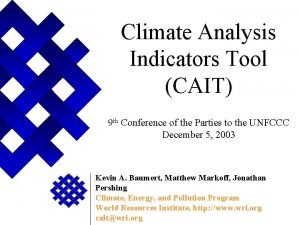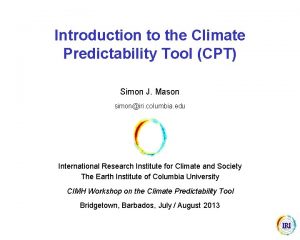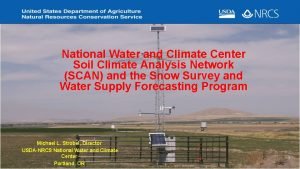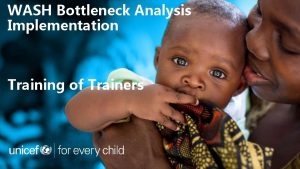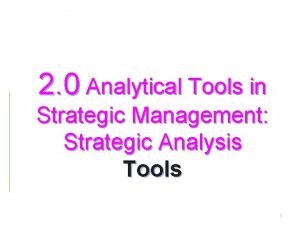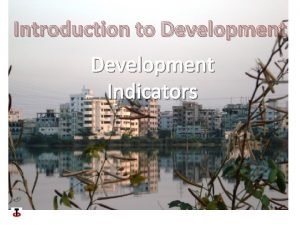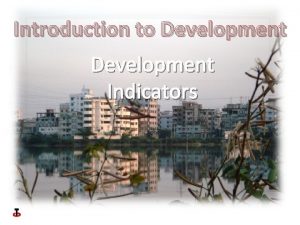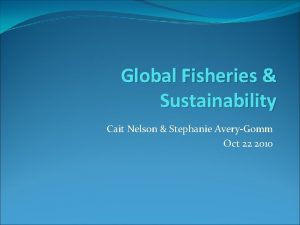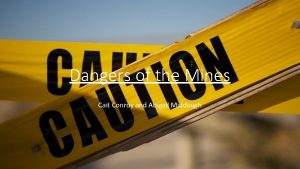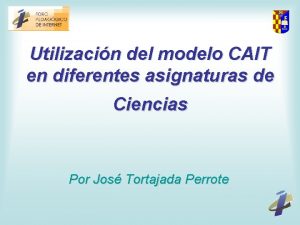Climate Analysis Indicators Tool CAIT 9 th Conference














- Slides: 14

Climate Analysis Indicators Tool (CAIT) 9 th Conference of the Parties to the UNFCCC December 5, 2003 Kevin A. Baumert, Matthew Markoff, Jonathan Pershing Climate, Energy, and Pollution Program World Resources Institute, http: //www. wri. org cait@wri. org WRI

Outline of Presentation • • • Introduction & Overview Description of CAIT Accessing CAIT and CAIT-Web Forum – • • http: //cait. wri. org Demonstration of CAIT Q&A WRI

Climate Analysis Indicators Tool (CAIT) • • • Excel-based information and analysis tool User-friendly interactive database Includes a wide range of climate-relevant data and indicators covering UNFCCC Parties and some non-Parties (plus aggregate “regions”) Can support decision-making processes and help build capacity Promotes greater access to information Policy neutral WRI

Indicators in CAIT • • Indicator selections made on the basis of Climate Convention principles and language, such as responsibility, capability, national circumstances, etc. Three Categories 1. GHG Emission Indicators 2. Socio-Economic Indicators 3. Natural Factor Indicators • Indicator Framework Paper – Detailed listing of sources and methods WRI

1. GHG Emissions • Indicators: 1. 2. 3. 4. Annual Emissions Cumulative Emissions Contributions to Concentration Increase Contributions to Temperature Increase • Country-level data: – CO 2 from fossil fuels and cement • • – – fossil fuel combustion: 1850 -2000 (IEA, CDIAC) cement manufacture: 1928 -2000 (CDIAC) CO 2 from land use changes: 1950 -2000 (Houghton/FAO) Five non-CO 2 gases: 1990, 1995, 2000 (EPA, EDGAR) WRI

2. Socio-Economic Indicators • • GDP (PPP) (total and per cap) (World Bank) Education (literacy, enrollment) (UNDP) Health (healthy life expectancy) (WHO) Governance (World Bank) Energy use (total & per capita) (World Bank/IEA) Carbon intensity of economy (C/GDP) Carbon intensity of energy (C/E) Carbon intensity of electricity generation (C/Eel. WRI )

3. Natural Factors • Climatic conditions – Heating degree days (NOAA/WRI) – Cooling degree days (NOAA/WRI) • Resource endowments – Fossil fuel reserves (BP, WEC) – Carbon content of energy mix (World Bank/IEA) • Geography – Land area influenced by humans (important for transport emissions) (FAO) • Population (World Bank) WRI

Analysis Features • • • Compare Indicators Compare Countries Calculate Trends Graph Trends Aggregate Indicators into a Weighted Index View Projections WRI

WRI

WRI

WRI

WRI

CAIT DEMO WRI

Accessing CAIT http: //cait. wri. org 1. Web Download (preferred) – Go to http: //cait. wri. org – Register and Login to the site – Download CAIT, and supporting documents 2. CD-ROM. Email requests to cait@wri. org • CAIT use requirements: – Windows-based computer with Excel 2000 or 2002 – Change your Excel Security Settings to “Medium” or “Low” – You must Enable Macros when opening CAIT WRI
 Climate analysis indicators tool
Climate analysis indicators tool Cait rutgers
Cait rutgers Conocimiento situado
Conocimiento situado Climate change 2014 mitigation of climate change
Climate change 2014 mitigation of climate change Climate predictability tool
Climate predictability tool Potter's tool is data cleaning tool
Potter's tool is data cleaning tool Soil climate analysis network
Soil climate analysis network Firewall analysis tool
Firewall analysis tool Frequency analysis tool
Frequency analysis tool Hse management standards
Hse management standards Bottleneck analysis excel
Bottleneck analysis excel Tools of structured analysis
Tools of structured analysis Strategic analysis techniques
Strategic analysis techniques Ehsan khodarahmi
Ehsan khodarahmi Hse management standards analysis tool
Hse management standards analysis tool
